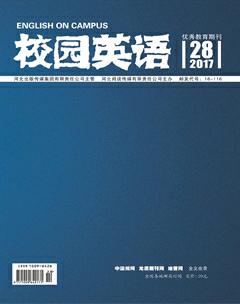On the Translation Methods of English Advertising Slogans
杨怡伦
【Abstract】Advertisement is playing a direct role in the development of society. As for the same advertisement, Chinese and English translation is different because some meanings of words between languages have no equivalence and different foreign advertisements have a special background meaning and symbolize their own customs and cultures. This thesis enables people to know more about the translation methods and features of advertising slogans.
【Key words】advertisement slogans; culture difference; translation methods; features
1. Introduction
As we know, loud advertising slogans can attract many customers curiosity and draw peoples attention to a certain kind of product. We usually inadvertently see and hear some advertisements when we watch TVs and walk on the street. Although a household advertisement is always simple, it is easy to remember and makes the customers long for visiting the stores and buy the products, from which we can learn the artistic and practicality of the English advertising slogans.
2. features of English Advertising Slogans
The language of the English advertising slogans has its unique features in lexical and rhetorical devices, which will create huge commercial profit by performing the implication of their products, and show perfect characteristics of the products.
2.1 Syntactic feature in the Advertising Slogan
First to talk about is declarative sentences used in factual description of E-C advertising slogans, which introduce the information and the view of the advertisement. Simple as it is, it catches customers eyes in a straightforward way. The second is imperative sentences to talk about. In our daily life, we can notice many types of slogans using imperative sentence to make consumers trust company. The third to talk about is exclamatory sentences, which can touch the audience in emotional and visual sense to express strong emotions.
2.2 Lexical Feature in the Advertising Slogan
Not only should advertising slogans describe the products and service vividly, but also slogans should be simple and catchy. So the application of part of speech is significant.
First to study is noun in the advertising slogans, which is always the name of a product, the most important information in an ad, and shows the brand of the product, which can tell customers what to buy. Next is verb widely used in advertising languages that is simple to understand and give direct impression to the customers, which can help the businessmen reach the goal that is A (Attention), I (Interest), D (Desire). Next to talk about is adjective. The advertising slogans prefer adjectives which are often harnessed in daily communication, the function of which is to describe and confine the nouns. And adjectives have the form of comparative and superlative, which businessmen can use to point the superiority of the products and stimulate consumers curiosity of product.endprint
3. Translation Methods of English Advertising Slogans
3.1 Literal Translation Method
Literal translation is word-for-word translation or rigid translation. To reach the goal of “faithfulness, expressiveness and elegance”, we should consider every aspect of the translation of target language, including word forms and language styles to avoid ambiguity of the meaning of the source language and error of the sentence structure. Generally speaking, literal translation is the simplest and the most commonly used to translate the advertising slogans.
3.2 Free Translation Method
Free translation, also named dynamic or functional equivalence translation, is another major means to translate advertising slogans. We usually have to change grammatical structure to express what the original advertising slogan shows. In contrast to literal translation, free translation can make the target text more understandable, and easy to be bore in mind by readers.
3.3 Adaptive Translation Method
Every language has its special way to transmit its meaning, so when we consider cultural and linguistic differences, we can use the method of adaptive translation to fully express the meaning of the source slogans and help the customers understand better and have the courage to consume.
3.4 New Translation principle
When we translate, we should focus on the psychological adaptation of the customers and the background of the advertising slogans, such as Chinese culture was deeply influenced by Confucians and emphasis on the quality of the products and the service by highlighting the characteristic of the products.
4. Conclusion
In summary, advertisement is the integration of language and commerce, which plays a critical part in todays economic communication. So we should study how to use the different methods in different situations and we should take every factor into consideration including linguistic characteristics and cultural difference and so on.
References:
[1]董成.英漢翻译综合技能教程[M].东北师范大学出版社,2010.
[2]冯庆华.实用翻译教程[M].上海外语教育出版社,2010.
[3]Leech,N.1966.The Language in Advertising[M].London: Longman.endprint

